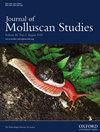Did Captain Beechey see a living Mandarina luhuana, an extinct land snail species?
IF 1.2
4区 生物学
Q2 MARINE & FRESHWATER BIOLOGY
引用次数: 0
Abstract
ABSTRACT Knowledge about prehuman biotas and the impact of early human contact, particularly on land snails inhabiting oceanic islands, is still poor. One specific example of interest is Mandarina luhuana, which was first collected from the Chichijima Islands of the Ogasawara Archipelago in 1827 during Captain Frederick William Beechey's expedition. The initial description of M. luhuana included an image of a shell with dark brown pigmentation, which contrasts with current understanding, with all known specimens being considered to lack dark colouration. Traditionally, it is believed that M. luhuana represents a fossil species that became extinct on the island before human arrival. However, I propose that the specimen collected for the original description was either recently dead or still alive at the time of collection. Furthermore, I hypothesize that M. luhuana faced extinction after human arrival on Ogasawara, which began during the 17th century. To test this hypothesis, I used accelerator mass spectrometry dating to determine the extinction dates of subfossil samples of M. luhuana. The results of this study suggest that M. luhuana became extinct after the 17th century, with the species having possibly survived until the early 19th century. It is likely that the extinction of M. luhuana occurred shortly after human arrival in the islands. These findings underscore the need for further research to understand the impact of human arrival on island ecosystems and to uncover the original diversity of land snail faunas on islands.比奇船长看到活的陆生蜗牛了吗,一种已经灭绝的陆地蜗牛?
关于前人类生物群和早期人类接触的影响,特别是对居住在海洋岛屿上的陆地蜗牛的影响,我们的认识仍然很少。一个特别有趣的例子是Mandarina luhuana,它于1827年在Frederick William Beechey船长的探险期间首次从小笠原群岛的Chichijima群岛收集。最初对M. luhuana的描述包括一张带有深棕色色素沉着的贝壳图像,这与目前的理解形成对比,所有已知的标本都被认为缺乏深色。传统上,人们认为M. luhuana代表了人类到达之前在岛上灭绝的化石物种。然而,我认为,在最初的描述中收集的标本要么是最近死亡的,要么是在收集时还活着。此外,我假设在17世纪人类到达小笠原之后,M. luhuana面临灭绝。为了验证这一假设,我使用加速器质谱测定法来确定M. luhuana亚化石样本的灭绝日期。这项研究的结果表明,M. luhuana在17世纪之后灭绝,该物种可能一直存活到19世纪初。很可能在人类到达这些岛屿后不久,M. luhuana就灭绝了。这些发现强调需要进一步研究,以了解人类到来对岛屿生态系统的影响,并揭示岛屿上陆地蜗牛动物群的原始多样性。
本文章由计算机程序翻译,如有差异,请以英文原文为准。
求助全文
约1分钟内获得全文
求助全文
来源期刊

Journal of Molluscan Studies
生物-动物学
CiteScore
3.00
自引率
8.30%
发文量
36
审稿时长
3 months
期刊介绍:
The Journal of Molluscan Studies accepts papers on all aspects of the study of molluscs. These include systematics, molecular genetics, palaeontology, ecology, evolution, and physiology. Where the topic is in a specialized field (e.g. parasitology, neurobiology, biochemistry, molecular biology), submissions will still be accepted as long as the mollusc is the principal focus of the study, and not incidental or simply a convenient experimental animal. Papers with a focus on fisheries biology, aquaculture, and control of molluscan pests will be accepted only if they include significant advances in molluscan biology. While systematic papers are encouraged, descriptions of single new taxa will only be considered if they include some ‘added value’, for example in the form of new information on anatomy or distribution, or if they are presented in the context of a systematic revision or phylogenetic analysis of the group.
 求助内容:
求助内容: 应助结果提醒方式:
应助结果提醒方式:


